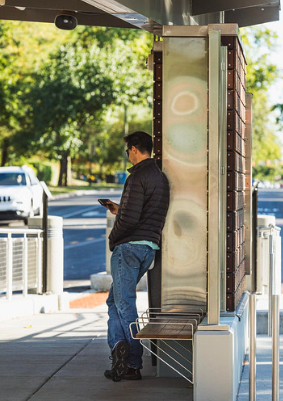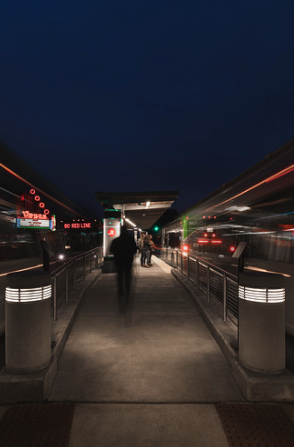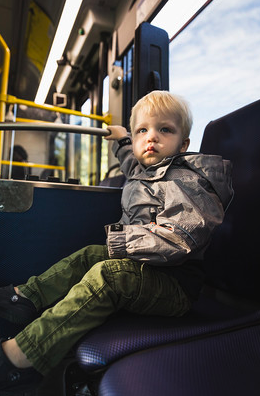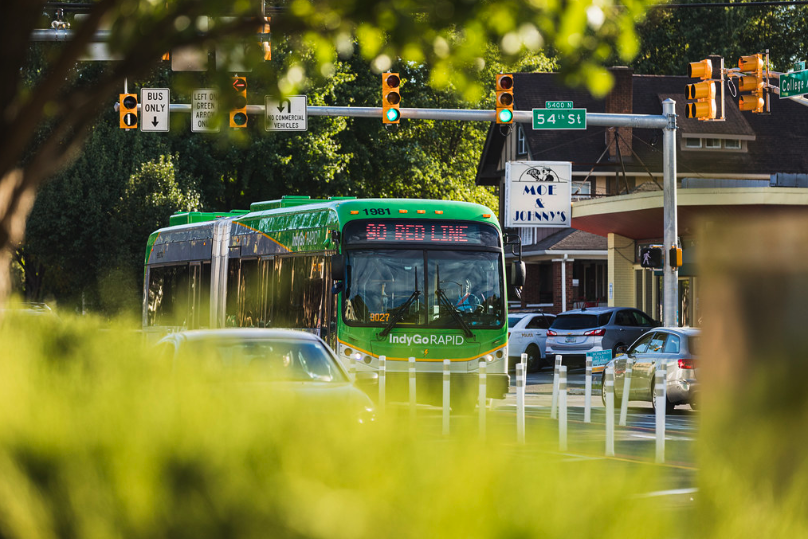The IndyGo Bus System Has Made Its Way to Broad Ripple
Photographer / Michael Durr
 The IndyGo Red Line rapid-transit electric bus system has been operational since September 1, and midtown occupants, residential and commercial alike, have been acclimating themselves to both the system itself and the resulting changes to car, bike and pedestrian traffic since then.
The IndyGo Red Line rapid-transit electric bus system has been operational since September 1, and midtown occupants, residential and commercial alike, have been acclimating themselves to both the system itself and the resulting changes to car, bike and pedestrian traffic since then.
Lauren Day, IndyGo’s director of public relations, says IndyGo officials are keeping a close eye on Red Line functionality and its effect on traffic flow and have begun to correct issues that arose in the first few weeks of operation such as longer-than-expected wait times and bus spacing problems.
“We’re working with our drivers and our dispatch and continuing to get better on the spacing of the buses, reducing some of the bunching that some of our riders have experienced,” she says. “We had an unexpected manpower shortage in late September, which some of our riders felt, and that hasn’t happened since.”
Implementation of the Red Line resulted in lane reductions due to bus-only lanes and fewer opportunities for left turns, necessitating increased U-turns at left-turn lights. Rebecca Dickerson, manager at Old National Bank’s Broad Ripple branch on North College Avenue, says some of her customers are still getting used to such changes.
“We’re a very busy branch, and the biggest thing that has affected us is customers not knowing how to get to us — especially if they’re coming from the north and need to get to us on the left,” she says. “So we’ve been trying to coach them on making the U-turn at the light by us. I’ve also seen a few people turn and drive over the dividing bump that’s meant for the buses. Hopefully, people are getting used to that and no one gets into a really bad accident.”
 Leah Olinger, owner of Pure Barre at North College and Broad Ripple avenues, observed increased traffic congestion through Broad Ripple Village’s main and secondary streets during the nearly six months of construction for the Red Line and through September after its opening.
Leah Olinger, owner of Pure Barre at North College and Broad Ripple avenues, observed increased traffic congestion through Broad Ripple Village’s main and secondary streets during the nearly six months of construction for the Red Line and through September after its opening.
“Traffic seemed pretty bad for a while, and for us, that’s always an issue with customers trying to make it to class on time, but it seems like it’s starting to steady out,” she says. “I think there has been more foot traffic around here, and that’s positive for all the restaurants and shops.”
Day says IndyGo will undertake a traffic impact study in the spring to determine how, and to what extent, the Red Line and its changes to lane and signal configurations have affected local traffic.
“The study will help future conversations on signal timing, how traffic moves, if additional signage is needed and things like that,” she says. “So far we’re seeing good, consistent ridership numbers during the weekdays and on weekends. It’s fun to see people out there using it as though it’s always been there.”
Holly Waddington, store director at Fresh Thyme Farmers Market on North College, feels that any traffic and logistical issues that have arisen from Red Line construction and subsequent operation since early September are likely temporary and have been worthwhile to give Indy residents the option of a rapid and accessible transit system.
“When they were working on it all summer, there was maybe a little dip in our business, but not since then,” she says. “It really hasn’t affected us either way since they finished, with the number of customers coming in and how the store functions. I think (the Red Line) can bring more people to Broad Ripple from downtown and help the businesses here.”
The Red Line runs a 13.1-mile fixed course that includes 28 stops from 66th Street and College Avenue to south of downtown near the University of Indianapolis. Buses arrive in 10 to 20-minute intervals at stations that sit curbside and in the center of the street, and each station has a roof, benches, lighting, ticket kiosks, route maps, security cameras and an emergency call button, as well as monitors for arrival. Wi-Fi is available at stations and on buses, too.

Buses are equipped with yellow stop cords, and riders should pull the cord as their destination approaches to alert the driver, as buses may not stop at every station. Announcements are made as buses approach, arrive and leave each station.
Red Line buses also feature bike racks, and bicyclists must enter through the middle or rear doors to secure their bikes. Each rack can accommodate approximately two inches of wheel width, and riders with thicker tires are required to hold their bikes in the center of the bus. Wheelchair restraints are situated at the front of the buses, and riders in wheelchairs should spot the green handicap symbol on platforms indicating where to enter.
The Red Line makes stops near landmarks like the Children’s Museum of Indianapolis, the Indiana State Capitol and Garfield Park. There are currently no designated parking lots for Red Line use, and riders are encouraged to find metered and free parking in Broad Ripple or downtown.
Red Line hours of operation are:
- Monday through Friday from 5 a.m. to 9 p.m. every 10 minutes; 9 p.m. to 1 a.m. every 15 minutes
- Saturday from 6 a.m. to 1 a.m. every 15 minutes
- Sunday from 7 a.m. to 8 p.m. every 15 minutes; 8 p.m. to 10 p.m. every 20 minutes
For more on IndyGo’s Red Line bus system, including a map and detailed info on fares and passes, visit indygo.net/red-line.






